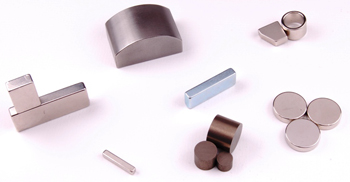-
Rare earth magnets and the lanthanide elements

- Impacts of free energy
- Notes from Nikola Tesla
- The book of Patrick Kelly
- Notes from Oliver Nichelson
- Energy draught from weak force ?
- Extraire de l'énergie à partir d'un champ de potentiel
- Orbo and the electromagnetic coupling
- Moteur à aimants permanents auto-alimenté
- Rare earth magnets and the lanthanide elements
- The tuning Fork
- Edition
-
Rare earth magnets and the lanthanide elements
Article published with kind permission of the author: Alan Smith - 12th of July.2010

Neo magnets from rare earth and Neodymium iron boron
Source: courtesy of Dura Magnetics, Inc.A short history of rare earth magnets and the lanthanide elements
Anybody who has a serious interest in alternative energy technologies of all kinds, wind power, hybrid vehicles and even Orbo will have come across the expression 'Rare-Earth Magnets' - usually referring to Neodymium magnets. But Neodymium is only one of a group of exotic elements like ytterbium, dysprosium, samarium -well, they seemed exotic only 40 years ago - which have become indispensable ingredients in many of the advanced technology products we use every day.
These elements are part of a group of 14 ‘lanthanide’ elements often -and rather inappropriately -called ‘rare earths’ because the mineral ores from which they were first isolated were uncommon oxide-type minerals which were sometimes generally referred to by refiners as 'earths'. The label is doubly misleading since these elements are neither rare or "earths" - it is merely an archaic metal refining term used to describe alkaline oxides of electropositive metals. Incidentally these were not able to smelted to extract the key metallic components until the 19th century.
Cerium is not rare, for example, but the 26th most abundant element in the Earth's crust, neodymium is more abundant than gold and even the rarest lanthanide (thulium) is more abundant than iodine . The lanthanides tend to become concentrated in less exploitable ore deposits so most of the world’s supply of these elements comes from only a few sources with China currently being the foremost producer.
Consumers may not know that their computer hard drives, TV screens, and smartphones contain rare earth elements. Europium for example is used in the the red phosphor in television screens and in energy-efficient LED light bulbs, while neodymium makes some of the most powerful magnets found in everyday electronics, wind turbines and hybrid cars. Lighter atomic weight lanthanides ranging from lanthanum itself to gadolinium on the periodic table of elements, while heavy rare earth metals range from terbium to lutetium. 'Green' technologies often depend upon a surprising amount of rare earth elements. Not many people realise that Toyota Prius manufacture absorbs an estimated 7,500 tons of lanthanum and 1,000 tons of neodymium a year, according to Jack Lifton, an independent consultant who works with U.S. Rare Earths, a company that owns the rights to rare earth element resources in the U.S. Neodymium magnets are currently the most compact and durable magnets available to industry, with their temperature stability (Curie point) bettered only by the lanthanide-based magnetic materials, Samarium-cobalt and Alnico.
Lanthanides are also used by the military in applications such as lasers, radar, missile-guidance systems, satellites and aircraft electronics.While on military matters (for the conspiracy theorists amongst us) it is worth pointing out that Afghanistan has probably the world's largest and as yet completely unexploited deposits of Lanthanides. The energy wars may have arrived at a new frontier already.
Rare earth magnets - A brief timeline of development
1966 - Dr. Karl J. Strnat working at the U.S. Air Force Materials Laboratory - Wright-Patterson Air Force Base, discovers the high energy product (18 MGOe - Mega Gauss Oersted) of the Samarium-Cobalt (SmCo5) compound.
1972 - Dr. Karl J. Strnat and Dr. Alden Ray develop a higher energy product (30 MGOe) Samarium-Cobalt (Sm2Co17) magnet.
1983 - Neodymium-Iron-Boron Magnets General Motors, Sumitomo Special Metals and the Chinese Academy of Sciences develop a high energy product (35 MGOe) Neodymium-Iron-Boron (Nd2Fe14B) compound.
Numerous patents are related to the development and manufacture of rare-earth magnetic products. Many of the patents related to Neodymium-Iron-Boron magnets are currently valid and enforced by their owners, particularly Sumitomo Special Metals Co., Ltd., and Magnequench, Inc. These are based on the original intellectual property of General Motors, Sumitomo Special Metals and The Chinese Academy of Sciences who independently discovered the new permanent magnet material composed of neodymium, iron and boron. Sumitomo and Magnequench have an agreement that covers the sale of Nd-Fe-B magnetic products in the United States. Although many of the basic Rare-Earth-Iron-Boron patents expired in 2003 there are a considerable number still in force. The following is a partial listing of some of the more notable U.S. patents in just one year after 2000, a pace which has not slackened since.
Feb., 2000 - Kanekiyo et al. develop iron-based permanent magnets and their fabrication as well as iron-based permanent magnet alloy powders for permanent bonded magnets and iron-based bonded magnets 6120620
Sep., 2000 - Benz et al. : Praseodymium-rich iron-boron-rare earth composition, permanent magnet produced therefrom, and method of making 6143193
Nov., 2000 - Akioka et al.: Rare earth bonded magnet, rare earth magnetic composition, and method for manufacturing rare earth bonded magnet 6168673
Jan., 2001 - Kanekiyo et al.: Sheet magnet having microcrystalline structure and method of manufacturing the same, and method of manufacturing isotropic permanent magnet powder 6261387
Comparative characteristics of different magnets
Maximum energy product Residual flux density Coercive force Working temperature Bh Max (MGOe) Br (Gauss) Hc (KOe) °C Ceramic 5 3.4 3950 2400 400 Sintered Alnico 5 3.9 10900 620 540 Cast Alnico 5 5.3 8200 1650 540 Samarium Cobalt 20 (1,5) 20 9000 8000 260 Samarium Cobalt 28 (2,17) 28 10500 9500 350 Neodymium 33UH 33 11500 10700 180 Neodymium N45 45 13500 10800 80 Table 1: Selected material magnetic properties
